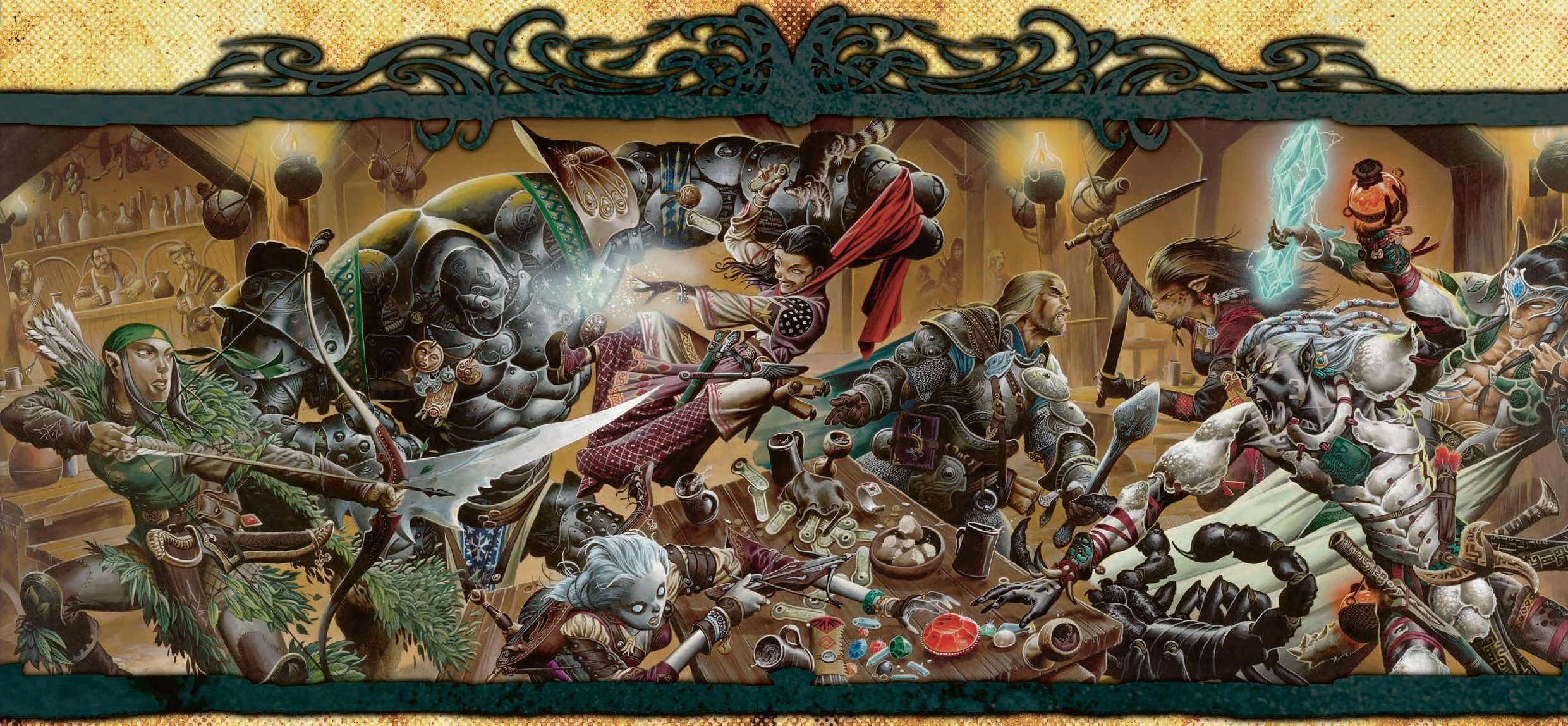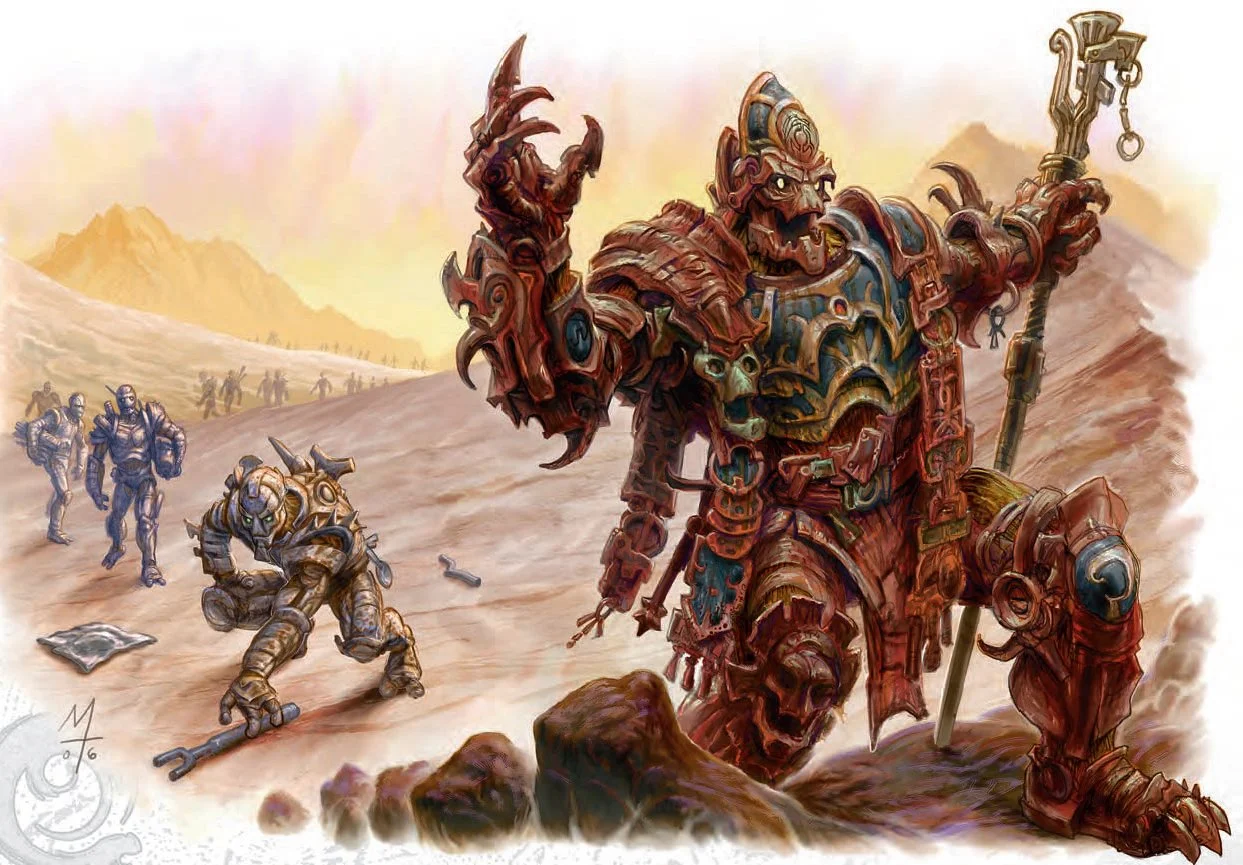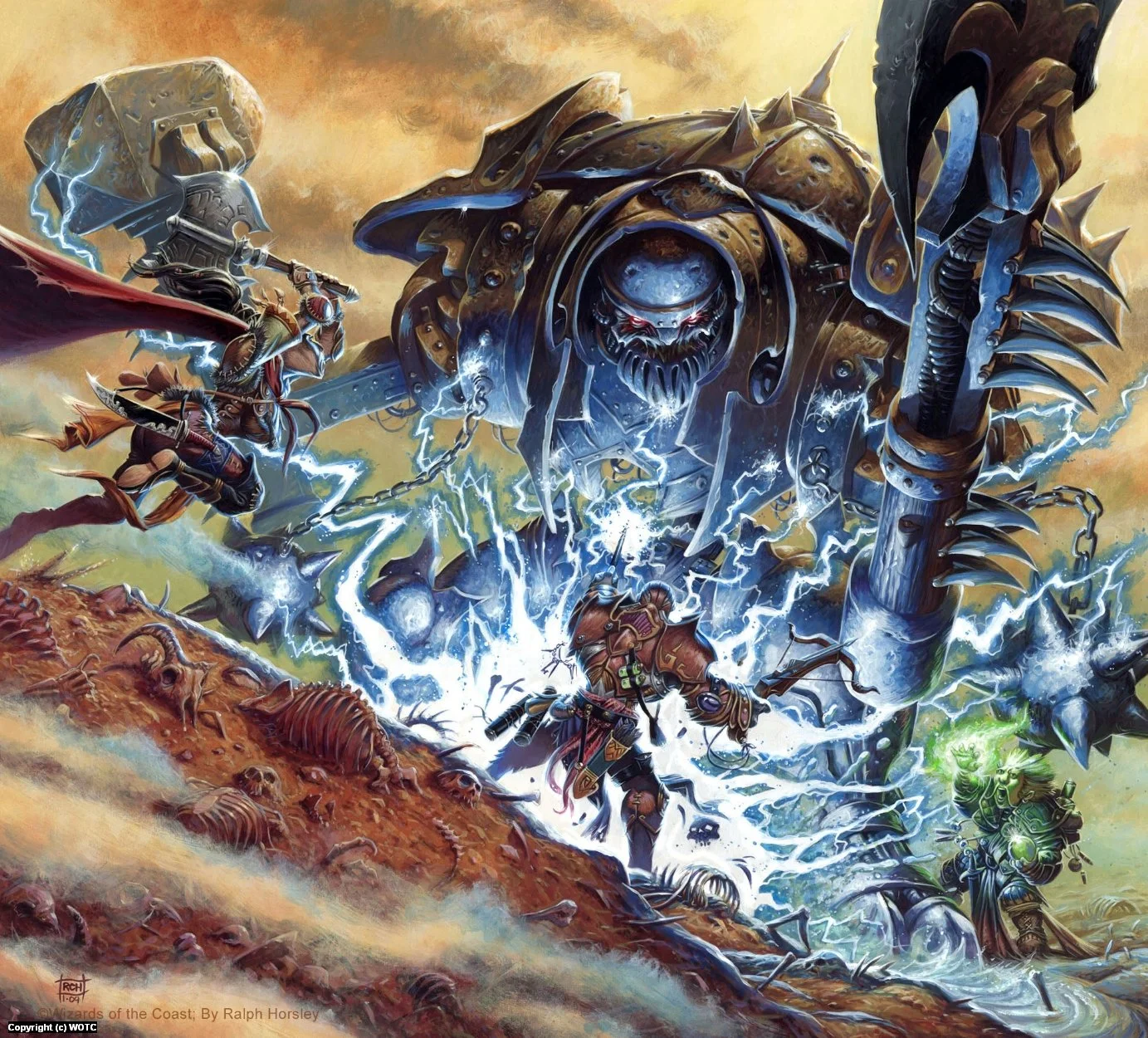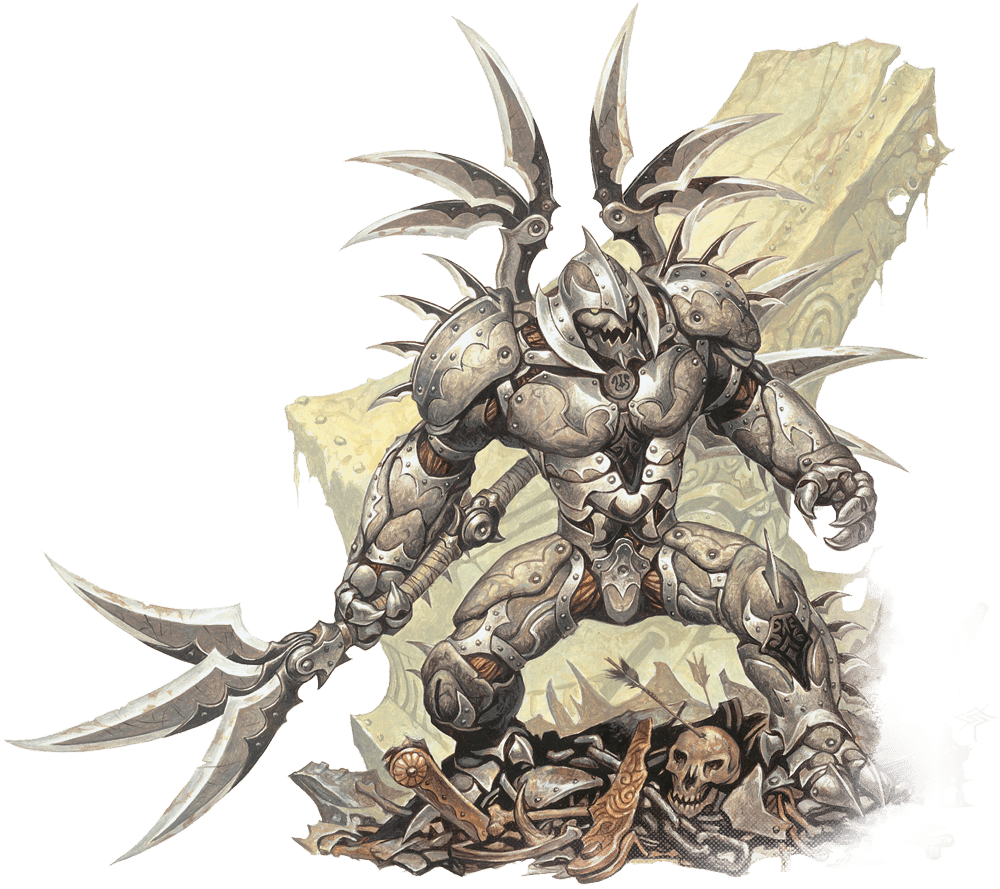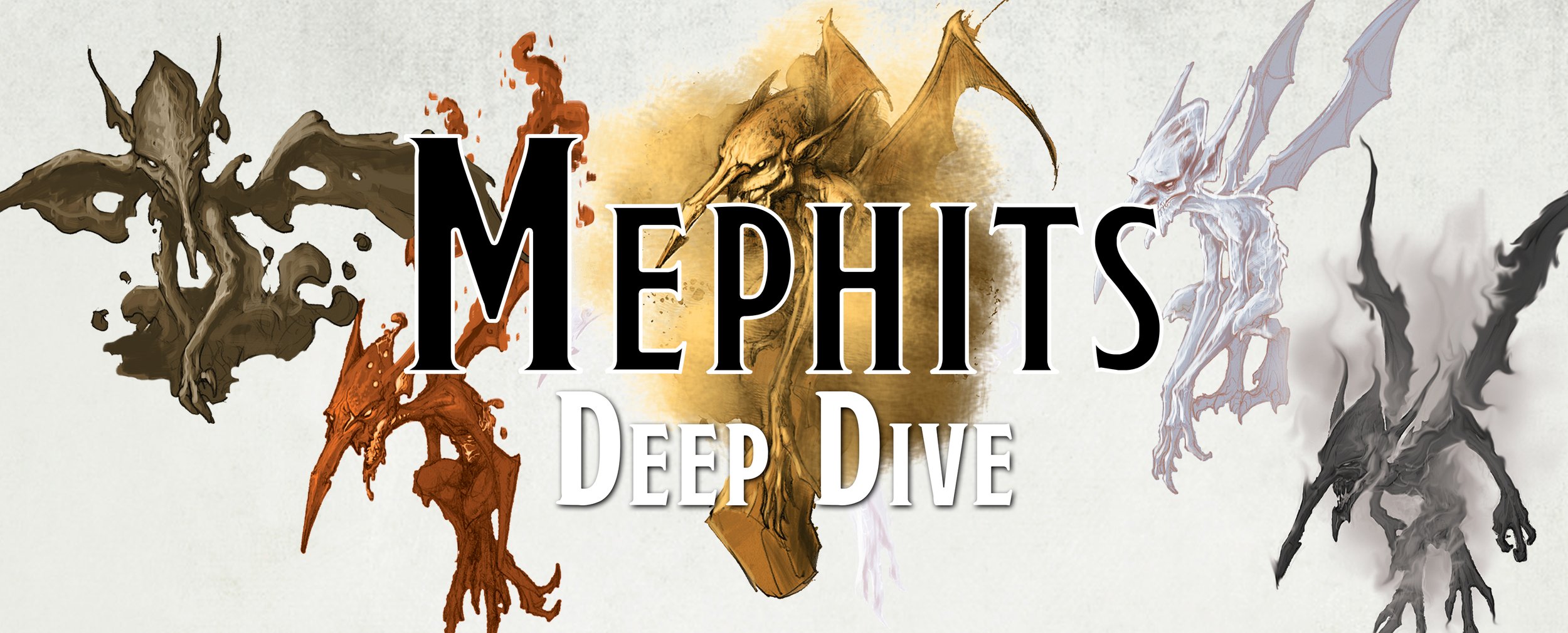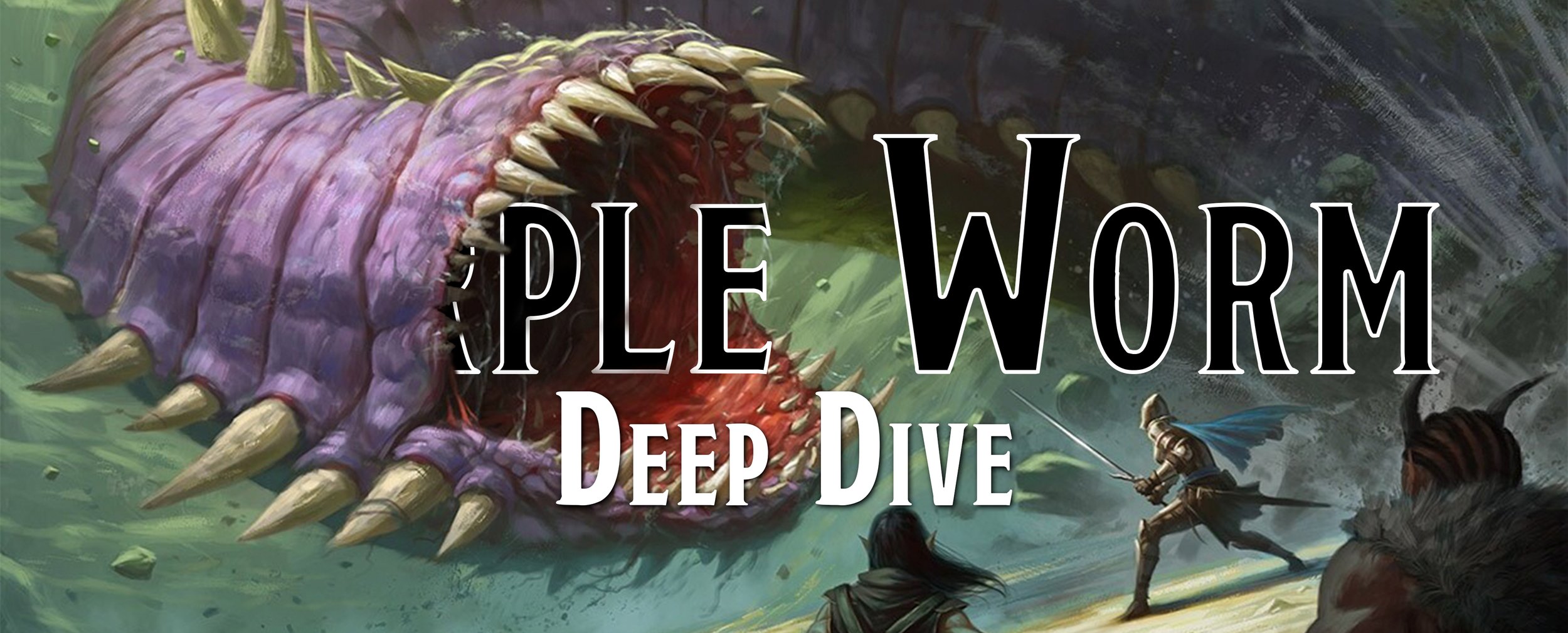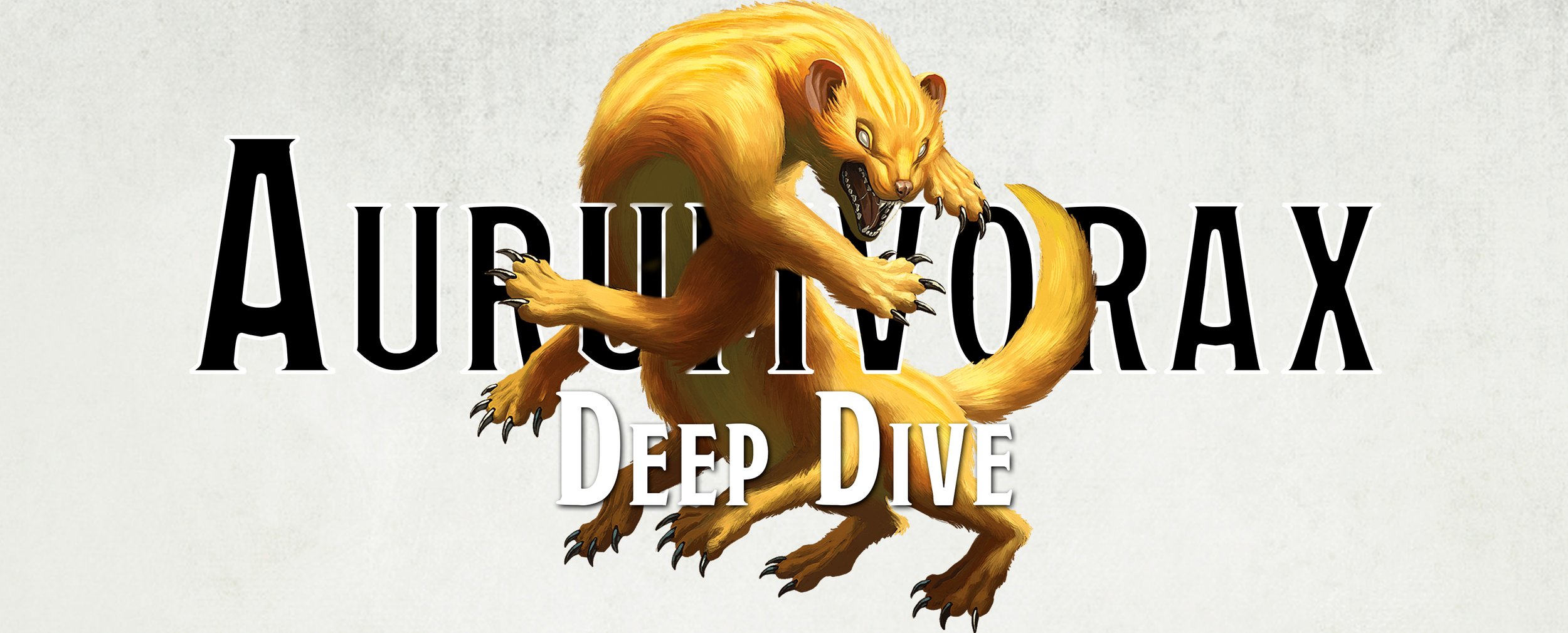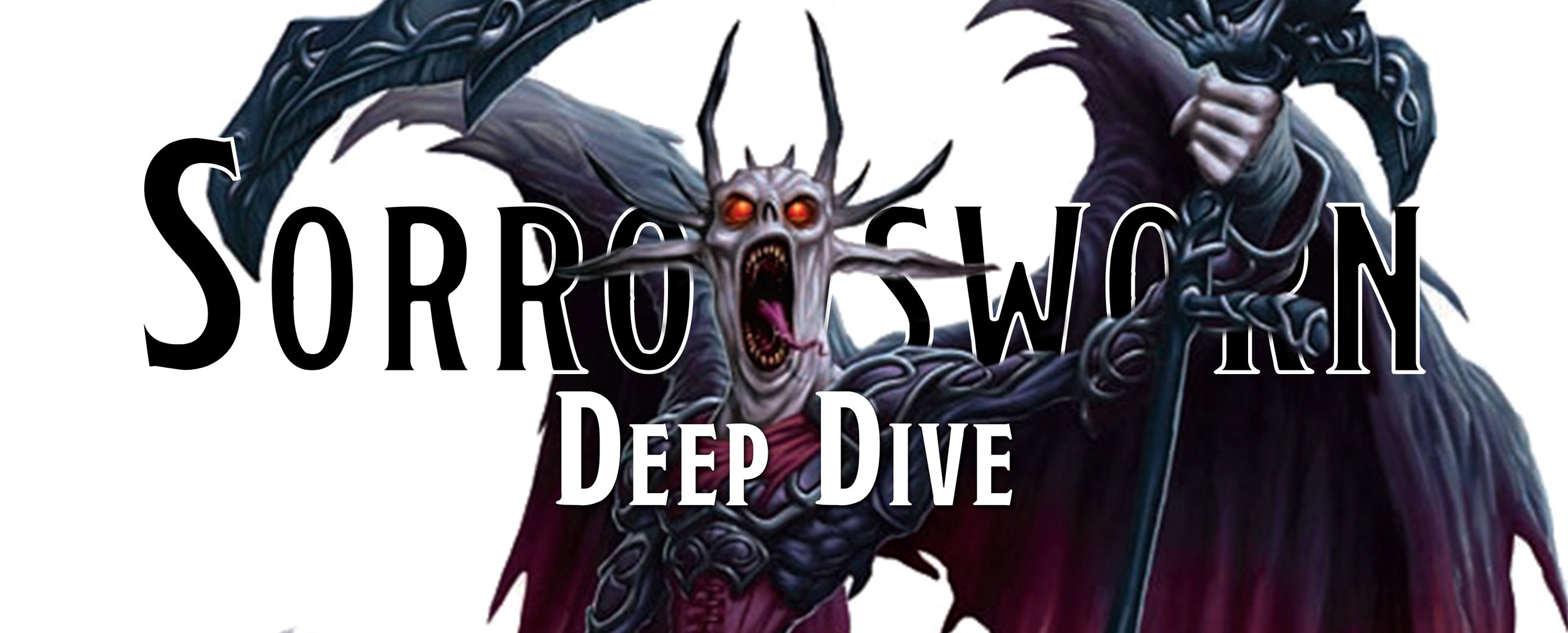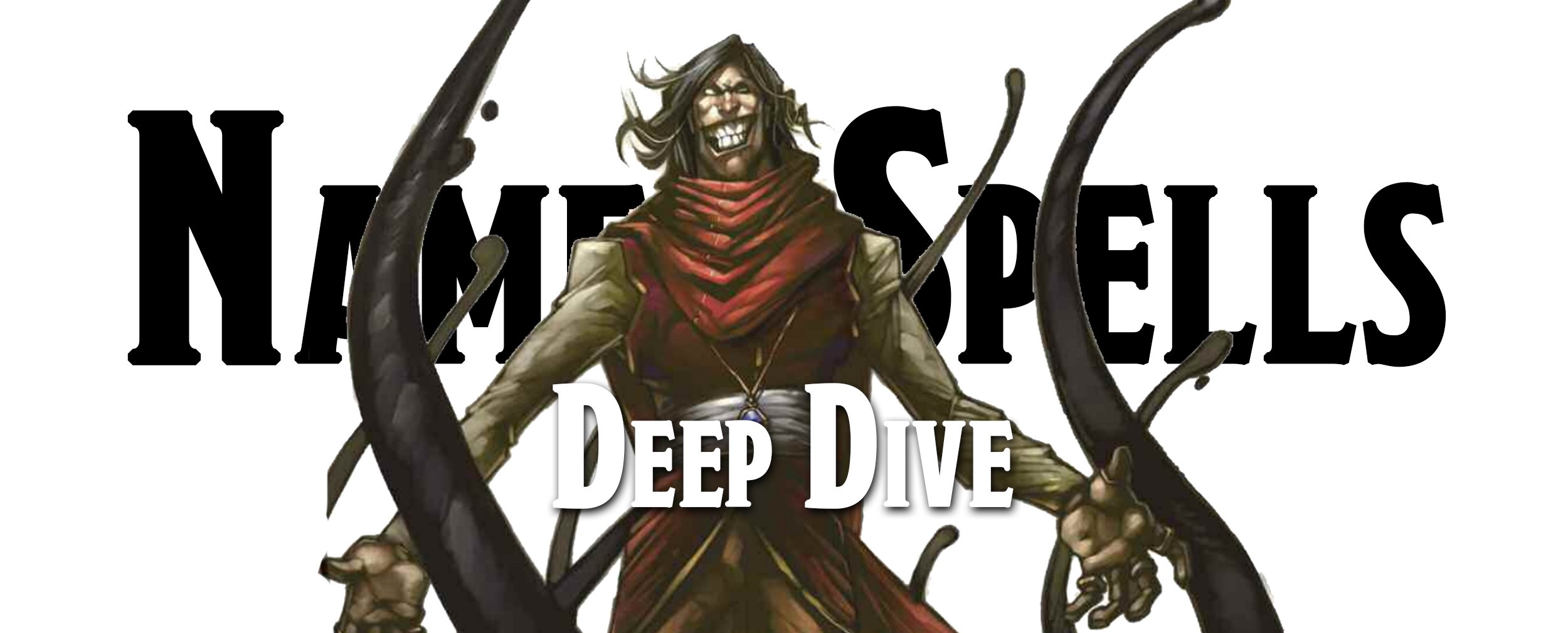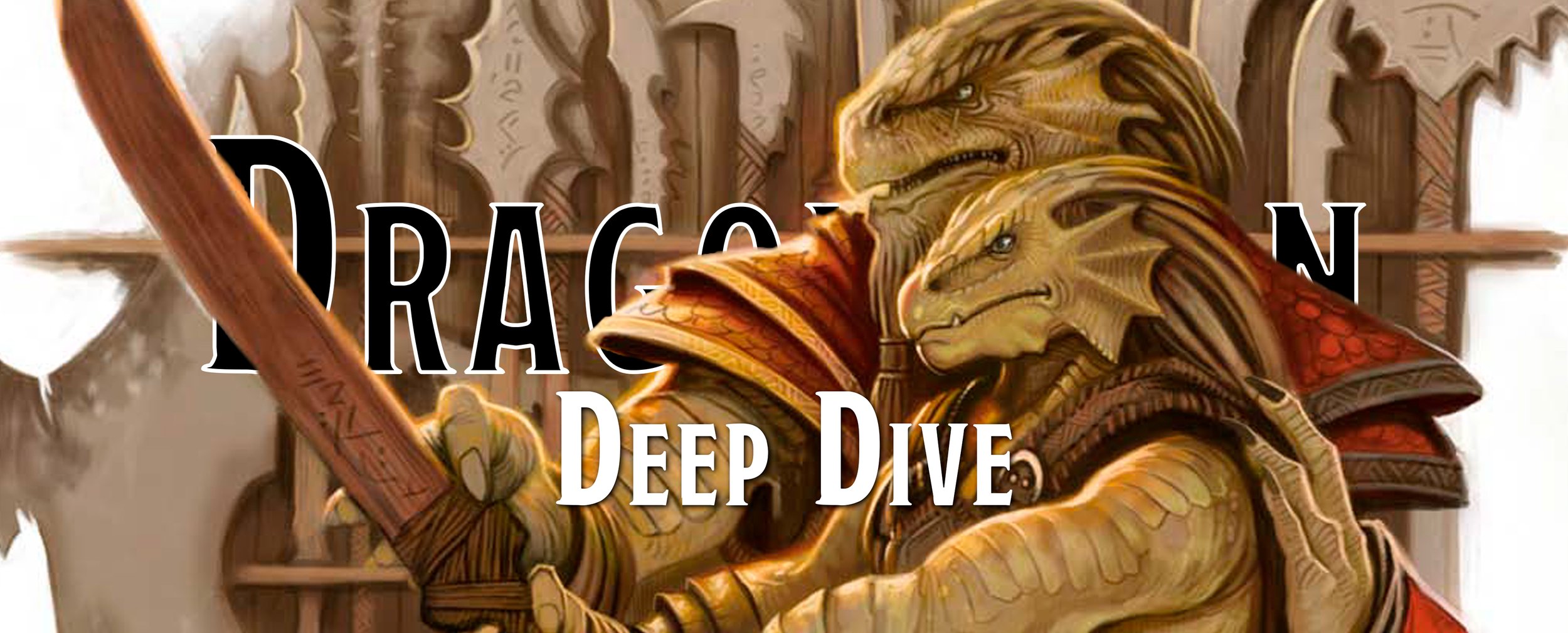Deep Dive - The Warforged
First forged in Eberron, the Warforged offered a chance to roll up a new character that wasn’t a boring human, a human with pointy elves, or a short human with a penchant for mining. Instead, you played as a living construct. There were benefits and detriments to embark on your adventure as a construct, but they were challenges to be embraced, not feared. Of course, the Warforged were also creatures to fight in cities and dungeons and were considerable foes. No matter what you think of players playing as a construct, the Warforged have left their mark on the multiverse.
3.5e Warforged
Stat Bonuses: +2 bonus to Constitution
Stat Penalties: -2 penalty to Wisdom & Charisma
Type: Construct
Armor Class: Composite Plating. The plating used to build a warforged provides a +2 armor bonus.
Living Construct Subtype (Ex): Warforged are constructs with the living construct subtype. A living construct is a created being given sentience and free will through powerful and complex creation enchantments. Warforged are living constructs that combine aspects of both constructs and living creatures.
Traits: A warforged possesses the following traits.
- Unlike other constructs, a warforged has a Constitution score.
- Unlike other constructs, a warforged does not have low-light vision or darkvision.
- Unlike other constructs, a warforged is not immune to mind-affecting spells and abilities.
- Immunity to poison, sleep effects, paralysis, disease, nausea, fatigue, exhaustion, effects that cause the sickened condition, and energy drain.
- A warforged cannot heal damage naturally.
- Unlike other constructs, warforged are subject to critical hits, nonlethal damage, stunning, ability damage, ability drain, and death effects or necromancy effects.
- As living constructs, warforged can be affected by spells that target living creatures as well as by those that target constructs.
- The unusual physical construction of warforged makes them vulnerable to certain spells and effects that normally don’t affect living creatures, such as heat metal.
- A warforged with 0 hit points is disabled. They can only take a single move action or standard action in each round, but strenuous activity does not risk further injury.
- A warforged does not need to eat, sleep, or breathe, but he can still benefit from the effects of consumable spells and magic items such as hre is no worry about the inner emotional struggleeroes’ feast and potions, although a warforged wizard must rest for 8 hours before preparing spells.
Languages: Common
Favored Class: Fighter
Eberron Campaign Setting, 2004 Wizards of the Coast / Sam Wood
The Warforged is first found in the Eberron Campaign Setting (June 2004). Along with the changling, kalashtar, and shifter, the Warforged was a new racial option, exploring the exciting setting of Eberron. All of these racial options were unique offerings, with each option taking an aspect normally prohibited from taking, like werewolf or construct, and allowing the players to play it, giving us the shifter or Warforged. Of course, while there are upsides to being a construct, there are several downsides as well.
The Warforged started as simple constructs built by House Cannith to fight in the Last War. The first Warforged were creatures of war, with a single focus on destroying their enemies. Nothing would stand in their way, and they fought with such resolve and ferocity that they were amongst the greatest warriors to war upon the battlefield. As the war raged on, House Cannith continued to improve and upgrade their fighting machines. With all this tinkering, their creations gained sentience, becoming not just constructs, but living constructs.
So now we have a bunch of Warforged living in Eberron, searching for a purpose in life after the Last War ended, especially as their kind is limited in number. House Cannith was banned from creating more Warforged as part of the treaty they signed to end the Last War and they are unable to reproduce. But Merrix d’Cannith, being the bad boy he is, continued to create them secretly. Maybe Merrix is building a secret army, or wanted to make a few friends to keep a game of Dungeons & Dragons going for more than a few sessions.
Races of Eberron, 2005 Wizards of the Coast / Steve Prescott
Even though the Warforged have emotions, they aren’t in touch with them. Depending on your outlook, it might be a benefit that they don’t have to worry about internal emotional struggles that other races do. They roll with the punches, accepting the world they live in and embracing their position in life as creatures of war. Of course, not all Warforged are the same and emotions have different impacts on them. Some seek to live a peaceful life, while others plot revenge against their creators.
Warforged can play any class they wish, but as you can imagine, fighter and barbarian are the most common. They combine construct and living creature traits, which often work against them. They don’t have darkvision as most constructs do, but they do have their own Constitution score, which constructs do not. They are not immune to mind-affecting spells and abilities but retain a construct’s immunity to poison, sleep effects, paralysis, disease, nausea, fatigue, exhaustion, being sickened, and energy drain. They are also susceptible to spells like heat metal since they are made up of a combination of metal and wood. Lastly, as a living construct, a Warforged can be raised or resurrected but does not need to eat, sleep, or breathe. So it’s kind of the best of both worlds, a soul, but you don’t have to deal with the constant scam of needing food.
Races of Eberron, 2005 Wizards of the Coast / Wayne Reynolds
In the book Sharn: City of Towers (2004), we find a small population of Warforged living in the five different sections of the largest city in Khovaire. Most live in the Cogs, a deep set of warrens that serve as the industrial base for Sharn. They work the massive furnaces and foundries there. Most are nothing more than indentured servants, but progress has been made to raise up the Warforged and treat them as equals among the other inhabitants of Sharn. Our previously mentioned friend, Merrix d’Cannith, lives in Sharn, residing in one of the finest strongholds in the city. Known as the Cannith Forgehold, it is here that he uses one of the last creation forges to produce a new generation of Warforged in secret. Perhaps some adventurers should go figure out what to do about that.
Don’t think every Warforged you meet is a nice player character, as the Warforged Charger and Warforged Scout appear in the Monster Manual III (2004). The Charger is a large construct that looks like a gorilla. A gorilla that will run at you, knock you flat on your ass, then pummel your chest with its giant fists. The Warforged Scout is a small construct, about as big as your average halfing, and a majority of them are rogues. The Scout is excellent at doing reconnaissance and doing all sorts of spy stuff, like spying and sneaking.
Races of Eberron, 2005 Wizards of the Coast / Franz Vohwinkel
In Five Nations (2005), there is some information regarding the Treaty of Thronehold. So earlier, we discussed a treaty where House Cannith gave up the right to create additional Warforged. Ten years before the treaty's signing, King Boranel of Breland convinced his parliament to pass the Warforged Decree, which declared Warforged as sentient beings. They were given the same rights as any other citizen of Breland, but it was more about securing the Warforged's services on the battlefield. It was a first for the Warforged, and when other Warforged heard of this decree, they traveled to Berland to gain the same rights and, in turn, pledged themselves to Breland's side of the war. We are even given information about a very high-ranking Warforged, Three, who made quite a name for themselves as the king’s personal protector.
Then there is the mysterious Warforged, The Lord of Blades, who seeks to create an empire for the Warforged in the ruins of Cyre and rule all of Eberron by any means necessary. No one knows The Lord of Blades's origins, but the rumors and stories have only added to his infamy. His few fanatical Warforged followers are unwaveringly loyal, following him into battle without question. When not conquering land on the battlefield, The Lord of Blades and his Warforged attack other strongholds to free Warforged slaves. Many worry that if his army continues to grow in numbers, all of Eberron could be under threat.
Eberron Campaign Setting, 2004 Wizards of the Coast
Magic of Eberron (2005) brings us the Psiforged, a psionic version of the Warforged. The appearance is similar to other Warforged except for the large number of crystals within their bodies. They identify as a specific gender, unlike other Warforged, do not live amongst common Warforged, and are more likely to seek other races. They have powerful psionic abilities that allow them to strike with just their mind.
The Player's Guide to Eberron (2006) provides more lore on the Warforged, especially their creation and their role in the Last War, but for the most part, it is the same as can be found in the Campaign Guide. Faiths of Eberron (2006), on the other hand, explores a new side of the Warforged, with their burgeoning belief in religion and a higher power. A small but ever-increasing number of Warforged now believe in Onatar, the God of forge and fire. The Forge of the Sacred is enticing to Warforged who want to explore the emotional side of creation. There is also the Reforged. They aren't a religion but a philosophy that focuses on the living part of their nature. They desire to transform themselves into more natural beings, allowing them to experience life more intensely.
Then there is The Lord of Blades, whose followers are now, in our humble opinion, accurately described as a cult. Our proof? The Lord of Blades is a mysterious god-like figure, has fanatics who hang on his every word, and plenty of followers willing to die for their beliefs and to further his cause. Sounds like a cult to us.
Faiths of Eberron, 2006 Wizards of the Coast / Steve Prescott
There is still no definite lore about how The Lord of Blades came into existence. One thing is sure: his word is sacrosanct, and his followers would gladly lay down their lives in service of him. These followers, called Blades, could care less about the origins of the Warforged or if they have a soul. Instead, they are a military force. The chain of command is clearly defined, and there is never any dissent in the ranks, such a concept is utterly foreign to them. This cult seeks to control all of Eberron, and their numbers are growing steadily.
On the other side, are the Warforged who have pledged themselves to The Becoming God. These Warforged, who call themselves the Godforged, are confident in their belief that all Warforged have souls, which were granted to them by this God. Small sects of Godforged are found in the Mournland, and they often can be found engaging in heated arguments about the meaning of life for their race. Whether it is the question of having souls, what happens to them on their death, or determining their goals in life. One thing is for sure. The Godforged seek not to fight other races but explore their existence in this life and the next.
Faiths of Eberron, 2006 Wizards of the Coast
As you might imagine by its title, The Forge of War (2007) has many Warforged stuff within its pages. The timeline for the Last War calls the period between 965 and 979 the Rise of the Warforged. It is the era where the modern-day war Warforged was perfected. Many of the Warforged fought for all the Houses at one point or another. Especially as House Cannith moved on from being the only one with Warforged, selling their creations to any House that could afford them. As we already know, after years of conflict between the Five Nations of Khovaire, the Treaty of Thronehold ended the bloodshed, but more importantly to us, gave the Warforged the freedom they rightfully deserved.
Another year, another book with the City of Stormreach (2008) being all about, you guessed it, the great human city of Stormreach. You don't want to cause trouble within the city walls. The Stormreach guards handle most problems, but serious ones are when you're introduced to the Iron Watch. Most of the Warforged information revolves around the Iron Watch, detailing their role and lives as guardians and enforcers. These well-equipped Warforged know no fear and can quell any threat with extreme prejudice. It's no surprise that fighters and barbarians make up the majority of the Watch, though rogues and rangers are also part of this elite group, doing surveillance, acting as spies, and watching over the city.
The Adventurers Guide to Eberron (2008) has some pretty pictures of the Warforged but no new information on the race, so let's talk about the Eberron adventure modules, especially since the Warforged appears throughout various adventures. In Shadows of the Last War (2004), you explore the depths of Sharn, all while dealing with the agents of The Lord of Blades. You'll be dealing with a Warforged assault on the Lighting Rail in the fourth chapter of the adventure Whispers of the Vampire's Blade (2004). When you embark on the adventure Grasp of the Emerald Blade (2005), the big boss you face is a Primitive Warforged, a mindless construct housed inside the Creation Forge. Finally, a Warforged named Kray works with the saboteur Teglin Char in planting a bomb on the ship the Golden Dragon in the adventure Voyage of the Golden Dragon (2006).
Dragon #352, Feb. 2007 Paizo Publishing / Wizards of the Coast / Jon Hodgson
The next big dump of Warforged information appears in Dragon #352 (Feb. 2007) in the article Warforged, Fierce and Furious. The article supplies tables to roll on if you're dying to create a unique Warforged for your campaign, as well as a few handy magic items to take on your journeys.
It also talks about a new sect of Warforged called Eldritch Cruible. They have tasked themselves to find and destroy magical artifacts and powerful arcane weapons of war. The creators despise them, as Merrix d'Cannath is all about harnessing the power of such items. Little do most of the Eldritch Cruible Warforged know that the leaders of this sect plan to kill themselves and everyone in the sect. This is planned to happen after they feel they have rid the world of enough magical items; their purpose in the world is complete.
The Warforged comes out swinging in Dungeon #111 (June 2004) featuring our friend, The Lord of Blades, in the Critical Threats series. All you have to do is skim through the stat block for The Lord of Blades, and you'll realize it is a very critical threat and then some, even though he's not as high of a level as we thought. Listed as a Fighter 2/Artificer 5/Warforged Juggernaut 5, The Lord of Blades identifies as male, a rarity amongst their kind. He wields a keen, adamantine two-bladed sword and a masterwork longbow with +1 bane arrows. His body is covered in adamantine blades, which is problematic when he goes in for a grapple and hugs you tight against the skewering blades. We could go on and on about The Lord of Blades, but it’s time to move on to the next edition.
4e - Warforged
Ability Scores: +2 Strength, +2 Constitution
Size: Medium
Speed: 6 squares
Vision: Normal
Languages: Common
Skill Bonus: +2 Endurance, +2 Intimidate
Living Construct: You are a living construct. You do not need to eat, drink, breathe, or sleep. You never make Endurance checks to resist the effect of starvation, thirst, or suffocation. All other conditions and effects affect you normally.
Unsleeping Watcher: You do not sleep and instead enter a state of inactivity for 4 hours to gain the benefits of an extended rest. While in this state, you are fully aware of your surroundings and notice approaching enemies and other events as normal.
Warforged Resilience: You have a +2 racial bonus to saving throws against ongoing damage. Also, when you make a death saving throw, you can take the better result of your die roll or 10.
Warforged Mind: You have a +1 racial bonus to your Will.
Warforged Resolve: You have the warforged resolve power.
Eberron Campaign Guide, 2009 Wizards of the Coast / Adam Gillespie
The first sighting of the Warforged is in the Monster Manual (2008) with the Warforged Soldier and Warforged Captain, neither of which is exciting or brings much to the table. Where we really start is with the Eberron Player's Guide (2009). For those who can’t get enough Warforged, you might be a bit saddened that we only have two books about Eberron in this edition, though that’s still twice as many as in the next edition. Luckily, Dragon magazine is more than happy to fill in that hole in this edition.
One of the most significant changes is that the Warforged is no longer considered a construct but a humanoid. Their skeleton consists of metal and stone, and a wood fiber makes up their muscular system. For their blood, they have a system of tubes inside that allows a fluid to flow through them, nourishing and lubricating systems. Lastly, their skin is composed of small stone and metal plates.
As a Living Construct, a Worforged doesn't have to eat, drink, breathe, or sleep. This means the Warforged doesn’t have to worry about walking through the desert or along the bottom of the ocean, unlike those squishy humans who think so highly of themselves. That's where the fun ends, though, as they are still susceptible to all other conditions.
But don’t think that when you select your character race, that that is all you have to look forward too. The Warforged is given a Paragon Path option to highlight just how Warforged they are. The Warforged Juggernaut craves nothing more than to be on the battlefield, leading the charge and pummeling their foes into a bloody pulp. They are quick to throw themselves into battle, blasting into enemies and defeating any challenge they face.
Eberron Campaign Guide, 2009 Wizards of the Coast / Ralph Horsley
Up next is the Eberron Campaign Guide (2009) rehashing the Warforged's role in Eberron. The book talks about where they can be found, their relationship, past and current, and The Lord of Blades, but provides no worthwhile new information to highlight.
Jumping away from sourcebooks, we get the adventure Khyber's Harvest (2009) where dark secrets of House Cannith can be found. As you are venturing through a cavern, you encounter three Warforged prototypes abandoned by House Cannith after the war: the Berserk Warforged, Decrepit Warforged, and the Infiltrator Warforged. An arcane generator controls them, and you guessed it, the party must shut it down or die at the hands of the prototypes. Sounds easy enough so long as you don’t die.
Dragon #364 (June 2008) gets us going with the article Playing Warforged by Chris Sims. The information is almost identical to the Eberron Player's Guide, but there is an interesting change as they are no longer connected to House Cannith. Instead, their origins revolve around the empire Nerath, its Society of Imperial Artificers, Creation Forges, and a war not named the Last War.
Eberron Player’s Guide, 2009 Wizards of the Coast / Adam Gillespie
The Warforged were supposed to be an autonomous being that didn't require another, say an elemental, to bring it to life. It was to be a new race that could learn and feel. War derailed that romantic notion, and the Warforged were built and sold to fight and defend Nerath from its attackers. Even after the war ended, more Warforged were created. New Warforged must serve in the military but, upon completion, are free to do as they please.
In Dragon #377 (July 2009), the Warforged are discussed in relation to an artificer's familiar. As disturbing as it seems, an Artificer Warforged could have a tiny familiar that looks like a Warforged. Dragon #380 (Oct. 2009) tells us how good a Warforged barbarian is as if we didn't already know.
Dragon #385, March 2010 Wizards of the Coast / Tyler Walpole
Dragon #385 (March 2010) contains the article Winning Races: Alchemical Warforged by Logan Bonner. Some Warforged feel incomplete, as if something is missing from their lives. So, to fill this hole, they add alchemical components to themselves, which requires them to reforge themselves. During this process, they must enfuse their body with various alchemical liquids. When the process is done, the Alchemical Warforged can feel more, sense more, and have a slew of new traits and components at their disposal.
If you want to uncover more lore on the Warforged, all the while adventuring in Eberron, Dungeon #167 (June 2009) contains the adventure Heart of the Forbidden Forge. As is a rule, anything dealing with Eberron and having the word ‘forge’ in it must involve Warforged. The adventure involves a lost Creation Forge and instructions for creating Infiltrator Warforged, and it is up to the adventurers to help the artificer, or destroy it.
In Dungeon #181 (August 2010), there's the adventure Explore Taer Lian Doresh which gives us some valuable insights into The Lord of Blades. The party encounters Adjuvant, an envoy for The Lord of Blades, and they have to make a decision. Either they can help Adjuvant fight against a group, or they can fight Adjuvant and maybe defeat him.
Wayfinder’s Guide to Eberron, 2018 Wizards of the Coast / Chippy
The grandest adventure involving Warforged is saved for Dungeon #206 (Sept. 2012). Dead for a Spell is an adventure by Christopher Perkins and Scott Fitzgerald Gray where you and your friends start by investigating the murder of Lady Kelani, an important woman in Sharn who was secretly a member of an evil cult. She has stolen a spellbook that could very well be the cause of the Day of Mourning. If you're not familiar with the Day of Mourning, it was a time when a large part of Eberron exploded and laid waste to the surrounding area.
As luck, not luck, would have it, Lady Kelani was assassinated by a group of Warforged after they were told the location of the book, since Lady Kelani had thought they were allies. In fact, the Warforged worked for a rival named Drago Daarn. Without getting too bogged down in the nitty gritty, know that you'll have to deal with a slew of Warforged to solve the mystery of her murder and retrieve the spellbook.
5th Edition - Warforged
Ability Score Increase. Your Constitution score increases by 2, and one other ability score of your choice increases by 1
Constructed Resilience. You have advantage on saving throws against being poisoned, and you have resistance to poison damage. You don't need to eat, drink, or breathe. You are immune to disease. You don't need to sleep, and magic can't put you to sleep.
Sentry's Rest. When you take a long rest, you must spend at least six hours in an inactive, motionless state, rather than sleeping. In this state, you appear inert, but it doesn't render you unconscious, and you can see and hear as normal.
Integrated Protection. Your body has built-in defensive layers, which can be enhanced with armor: You gain a +l bonus to Armor Class. You can don only armor with which you have proficiency. To don armor, you must incorporate it into your body over the course of 1 hour, during which you remain in contact with the armor. To doff armor, you must spend 1 hour removing it. You can rest while donning or doffing armor in this way. While you live, your armor can't be removed from your body against your will.
Eberron: Rising from the Last War, 2019 Wizards of the Coast
The Warforged debuted in the 5th edition with the release of Eberron: Rising from the Last War (2019). This edition only has the one sourcebook on them, which is quite a big difference compared to the previous editions. But maybe this edition will have tons of new insights never before shared before!
Flipping through the book, there's the usual talk about the creation of the Warforged by House Cannith and how they were feared on the battlefield. It continues with the Treaty of Thronehold ending the creation of any more Warforged, granting them freedom, and their struggle to find a place called home. The problem is that this is all done in a single paragraph. Even the section on House Cannith says practically nothing about the Warforged.
Starting to think that we won’t get that expanded lore we were hoping for, but maybe we just need to look at the Warforged racial abilities. Sadly, reading through their background, appearance, personality, and quirks, we just get abridged versions of previous editions. We get the familiar construct, but not a construct, abilities like being resistant to poison, not having to eat, drink, breathe, or sleeping, and a bonus to Armor Class.
Eberron: Rising from the Last War, 2019 Wizards of the Coast / Steve Prescott
A bright spot in all this is when reading about The Lord of Blades. The authors stay true to the background of this cult leader Warforged, providing more detail about his anger and plans. If you are flesh and blood, The Lord of Blades sees death in your future at the hands of the Warforged, if you aren’t, you are probably already dead or you are a Warforged.
The book expands on The Lord of Blades when your campaign involves playing in the Last War. Instead of vague and unknown rumors, we get detailed rumors, like that The Lord of Blades didn't appear in his current form until after the Day of Mourning. Scholars claim he was named Bulwark, the personal bodyguard of King Boranel of Breland. Others think he was the final Warforged to be created in the forges at Eston before the Mourning. It would be impressive to survive the apocalyptic event, considering pretty much everyone else died. It may not be that far-fetched, though. The Warforged aren't affected by the residual effects of the Mourning that happened at the end of the Last War. That allows The Lord of Blades followers to thrive in the scorched remains of Mournland, searching for magical artifacts to use in their great war against flesh and blood humanoids.
The craziest of all the rumors is that Aaren d'Cannath, who created the first Warforged, transferred his consciousness into The Lord of Blades. Why, you may ask? They say he was so pissed off that his creations were made into weapons of war he became The Lord of Blades to seek vengeance. That vengeance went beyond House Cannith and extended to all living creatures. That's anger on a whole new level.
The Lord of Blades stat block reaffirms you don't want to go up against him without the mightiest of heroes by your side. His adamantine armor is also bladed armor, so forget critical hits and avoid being grappled. He is a powerful warrior, with his six adamantine blades, as well as a 20th-level spellcaster, capable of blasting any enemy with magic that decides they don’t want a Warforged overlord.
Eberron: Rising from the Last War, 2019 Wizards of the Coast
There's a series of adventure hooks when you want to take on The Lord of Blades and/or his followers. You could explore a Warforged Ossuary, a tomb buried deep in the Mournland for fallen Warforged. They could be summoned by The Lord of Blades, demanding they go see him. Or maybe an artificer is attempting to reactivate a destroyed Warforged colossus, which seems like a horrible idea.
Speaking of the Warforged Colossus, there's a section dedicated to these massive and deadly creatures. There are also stat blocks for the Warforged Titan and Solider, but they pale in comparison. As you may remember, House Cannith first created the mindless Warforged Titans. They were good at killing things but not so good at following orders. Next up was the Warforged we know and love. They were a force to be reckoned with and made House Cannith rich by selling their creations to anyone who could afford them. But House Cannith wasn't satisfied and kept tinkering and experimenting, leading to the Warforged Colossus. Most of these colossal creatures never saw the field of war, as they were destroyed when the Mourning happened.
The few that survived are non-operational. That is until you or possibly your enemy finds one and fires it up using a Khyber dragonshard. These gargantuan constructs were built to carry people, so if you get your hands on one, you can ride around in the world's biggest death machine.
Eberron: Rising from the Last War, 2019 Wizards of the Coast
The Warforged may not have been an original Dungeons and Dragons creature, but they have been shown a lot of love over the past three editions. While not everyone may be excited for a robot showing up in their game about fantasy elves and dwarves, the Warforged are thoroughly blended into fantasy and bring a whole new style of play to the table.
If you enjoy our Deep Dive series, consider
supporting us on Patreon
and following us on Facebook and Instagram!




